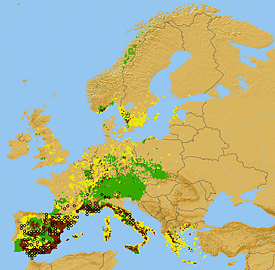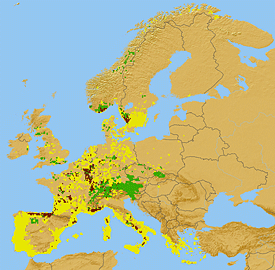Press release from the 12th of Dezember 2011
Economy and Ecology: Reconciling economic development and the conservation of Europe’s Biodiversity
Special Issue on ALARM Project Explores Europe’s Ecological Futures
Leipzig/Helsinki/Lund. As European leaders struggle to avert a second recession a new study finds that future economic growth and the sustenance of the continent’s ecosystem services may be incompatible, unless political priority setting focusses on sustainable development with a special emphasis on biodiversity conservation. The research, published in a special issue of Global Ecology and Biogeography, combines socio-economic, land use, climate and biodiversity models with other approaches to consider three possible routes for the future of Europe’s economy. The scientists explore the multiple impacts on biodiversity within the next century.

Butterfly Anthocharis euphenoides
Photo: Albert Vliegenthart


Current distribution of the butterfly Anthocharis euphenoides (open circles) and modelled suitable niche spaces of the butterfly (yellow), its
larval food plants (green) and their overlapping regions of co-occurrence (brown) for 2000 and for the global change scenario BAMBU for 2080.
See Schweiger et al., pp. 88-99.
Maps and design copyright: Alexander Harpke.
The special issue is edited by Josef Settele and Joachim Spangenberg from the Helmholtz Centre for Environmental Research - UFZ/Germany, Timothy Carter from the Finnish Environment Institute - SYKE/Finland, and Martin Sykes from the University of Lund/Sweden. It combines and integrates the outcomes of scenario research of the ALARM project (Assessing LArge-scale environmental Risks for biodiversity with tested Methods; www.alarmproject.net), which brought 250 scientists from 68 partner organisations of 35 countries together to explore potential future risks to Europe’s as well as global biodiversity and ecosystem services.
"Scenarios can provide a comprehensive view of plausible - not necessarily probable - future developments, and they can deal with complexity. This way they serve as a means to explore the possible future outcomes of decisions taken - or not taken - now" says Joachim Spangenberg, who led the scenario group of the project.
Within ALARM, scenarios developed are broad pictures of possible futures aiming to derive information on risks to biodiversity from a diverse range of factors during the 21st century. The three core scenarios are BAMBU (‘Business As Might Be Usual’), an extrapolation of current policy trends, and two alternative policy options, GRAS (‘GRowth Applied Strategy’) simulating a policy of deregulation and globalization, and SEDG (‘Sustainable European Development Goal’), a sustainable development policy scenario.
ALARM scenarios and the IPCC
The ALARM scenarios build upon different global scenarios developed by the Intergovernmental Panel on Climate Change (IPCC) Special Report on Emissions Scenarios (SRES), from which climate, economic and land use scenarios were derived for Europe. These, in turn, provided a reference base for developing vegetation, plant invasion and chemical deposition scenarios as well and for projecting future ranges of interacting species. All aspects of the scenario building process are dealt with in the special issue (see list of contributions, below).
"The SRES scenarios are due to be superseded by a new set of global socio-economic, technological, land-use, emissions and climate scenarios developed by the international research community ahead of the IPCC Fifth Assessment Report" adds Tim Carter. According to Martin Sykes, "this however should not imply that the ALARM scenarios will become invalid; rather the new scenarios can be regarded as complementary, providing richer and more regionally specific socio-economic characterizations than the SRES, some of which are still perfectly consistent with the ALARM biodiversity-orientated information."
Tim Carter, who is also one of the authors of the forthcoming IPCC report, concludes that "it will be an important task of the IPCC AR5 to assess how the new scenarios relate to SRES and to some other global scenario exercises. From this analysis it should then be possible to gauge the lasting value of the ALARM scenarios for continued application in the future."
Will EU policies be able to stop the loss of biodiversity?
"The scenarios tell us that the extension of current EU policies will act as a brake on current trends by slowing down the loss of biodiversity in many cases and in most biomes, but it will not be capable of halting or of reversing the loss. Liberalization has the effect of accelerating biodiversity loss across the board, with few exceptions. A coherent sustainability scenario is clearly the most effective at preserving biodiversity, but the variant tested here still does not halt losses in all cases", states Ingolf Kühn of UFZ, who also contributed to several papers of the special issue.
Joachim Spangenberg summarizes: "Generally, current EU policies for protecting biodiversity appear to be insufficient to reverse ongoing losses. Coherent sustainability strategies are effective at conserving biodiversity, but in order to reverse losses, the official objective of the new EU biodiversity policy, measures would need to be introduced that extend even beyond the steps tested in the ALARM sustainability scenario." "Only time will tell whether the ALARM scenarios will succeed in offering useful insights to a wider constituency of users" said Josef Settele, the ALARM coordinator and another author currently contributing to the IPCC Fifth Assessment Report. "Scenarios can play a valuable role in providing coherence to studies of future global change. This is especially true when such studies address multiple objectives and draw upon diverse disciplines and research traditions as we see in this special issue."
Publication
The Editorial is available at:
http://onlinelibrary.wiley.com/doi/10.1111/j.1466-8238.2011.00720.x/full
and the abstract of the Scenario overview paper at:
http://onlinelibrary.wiley.com/doi/10.1111/j.1466-8238.2010.00620.x/abstract
The issue’s TOC can be reached at (from Monday 12th of December onwards):
http://onlinelibrary.wiley.com/doi/10.1111/geb.2012.21.issue-1/issuetoc
Further information
PD Dr. Josef Settele
Helmholtz Centre for Environmental Research - UFZ
josef.settele@ufz.de
Dr. Joachim Spangenberg
Tel +49 345 558 5302
+49 171-3253105
joachim.spangenberg@ufz.de
Dr. Ingolf Kühn
Tel +49 345 558 5311
ingolf.kuehn@ufz.de
Dr. Oliver Schweiger
Tel +49 345 558 5306
oliver.schweiger@ufz.de
Doris Böhme (UFZ-Pressestelle)
Telefon: 0341 235 1269
presse@ufz.de
Papers in the Special Issue:
- Scenarios as a tool for large-scale ecological research: experiences and legacy of the ALARM project: Josef Settele, Timothy R. Carter, Ingolf Kühn, Joachim H. Spangenberg and Martin T. Sykes
- Scenarios for investigating risks to biodiversity: Joachim H. Spangenberg, Alberte Bondeau, Timothy R. Carter, Stefan Fronzek, Jill Jaeger, Kirsti Jylhä, Ingolf Kühn, Ines Omann, Alex Paul, Isabelle Reginster, Mark Rounsevell, Oliver Schweiger, Andrea Stocker, Martin T. Sykes and Josef Settele
- Representing two centuries of past and future climate for assessing risks to biodiversity in Europe: Stefan Fronzek, Timothy R. Carter and Kirsti Jylhä
- The socio-economic modelling of the ALARM scenarios with GINFORS: results and analysis for selected European countries: Andrea Stocker, Ines Omann and Jill Jäger
- Projecting the future distribution of European potential natural vegetation zones with a generalized, tree species-based dynamic vegetation model: Thomas Hickler, Katrin Vohland, Jane Feehan, Paul A. Miller, Benjamin Smith, Luis Costa, Thomas Giesecke, Stefan Fronzek, Timothy R. Carter, Wolfgang Cramer, Ingolf Kühn and Martin T. Sykes
- Potential implications of future climate and land-cover changes for the fate and distribution of persistent organic pollutants in Europe: Alexander G. Paul, Volker C. Hammen, Thomas Hickler, Ulrich G. Karlson, Kevin C. Jones and Andrew J. Sweetman
- Projecting trends in plant invasions in Europe under different scenarios of future land-use change: Milan Chytrý, Jan Wild, Petr Pyšek, Vojtech Jarošík, Nicolas Dendoncker, Isabelle Reginster, Joan Pino, Lindsay C. Maskell, Montserrat Vilà, Jan Pergl, Ingolf Kühn, Joachim H. Spangenberg and Josef Settele
- Increasing range mismatching of interacting species under global change is related to their ecological characteristics, Oliver Schweiger, Risto K. Heikkinen, Alexander Harpke, Thomas Hickler, Stefan Klotz, Otakar Kudrna, Ingolf Kühn, Juha Pöyry and Josef Settele
Im Helmholtz-Zentrum für Umweltforschung (UFZ) erforschen Wissenschaftler die Ursachen und Folgen der weit reichenden Veränderungen der Umwelt. Sie befassen sich mit Wasserressourcen, biologischer Vielfalt, den Folgen des Klimawandels und Anpassungsmöglichkeiten, Umwelt- und Biotechnologien, Bioenergie, dem Verhalten von Chemikalien in der Umwelt, ihrer Wirkung auf die Gesundheit, Modellierung und sozialwissenschaftlichen Fragestellungen. Ihr Leitmotiv: Unsere Forschung dient der nachhaltigen Nutzung natürlicher Ressourcen und hilft, diese Lebensgrundlagen unter dem Einfluss des globalen Wandels langfristig zu sichern. Das UFZ beschäftigt an den Standorten Leipzig, Halle und Magdeburg ungefähr 1.000 Mitarbeiter. Es wird vom Bund sowie von Sachsen und Sachsen-Anhalt finanziert.
Die Helmholtz-Gemeinschaft leistet Beiträge zur Lösung großer und drängender Fragen von Gesellschaft, Wissenschaft und Wirtschaft durch wissenschaftliche Spitzenleistungen in sechs Forschungsbereichen: Energie, Erde und Umwelt, Gesundheit, Schlüsseltechnologien, Struktur der Materie, Verkehr und Weltraum. Die Helmholtz-Gemeinschaft ist mit über 30.000 Mitarbeiterinnen und Mitarbeitern in 17 Forschungszentren und einem Jahresbudget von rund 3 Milliarden Euro die größte Wissenschaftsorganisation Deutschlands. Ihre Arbeit steht in der Tradition des Naturforschers Hermann von Helmholtz (1821-1894).
